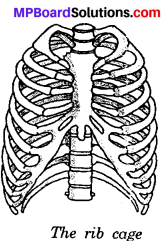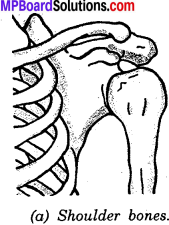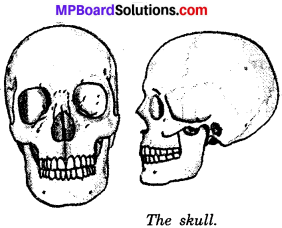MP Board Class 6th Science Solutions Chapter 8 Body Movement
Body Movement Textbook Exercises
Question 1.
Fill in the blanks:
- Joints of the bones help in the ……………………… of the body.
- A combination of bones and cartilages forms the …………………… of the body.
- The bones at the elbow are joined by a …………………….. joint.
- The contraction of the …………………….. pulls the bones during movement.
Answer:
- Movement
- Skeleton
- Balls socket
- Muscles.
![]()
Question 2.
Indicate true (T) and false (F) among the following sentences.
- The movement and locomotion of all animals is exactly the same.
- The cartilages are harder than bones.
- The finger bones do not have joints.
- The fore arm has two bones.
- Cockroaches have an outer skeleton.
Answer:
- False
- False
- False
- True
- True.
Question 3.
Match the items in Column I with one or more items of Column II.

Answer:
(i) – (d)
(ii) – (a) and (g)
(iii) – (e)
(iv) – (f)
(v) – (b) and (c).
Question 4.
Answer the following:
Question (a)
What is a ball and socket joint?
Answer:
The round end of one bone fits into the hollow space of the other bone. Such a kind of joint allows movements in all directions. Such joints are called ball and socket joints.
Question (b)
Which of the skull bones are movable?
Answer:
The facial bones of our skull comprises upper and lower jaw, in which lower jaws is movable.
Question (c)
Why can our elbow not move backwards?
Answer:
Elbow cannot move backwards because it has hinge joint which allows only back and forth movements.
![]()
Projects And Activities
Activity 1.
Make a table to show how do animals move from place to place?
Answer:
Movement of Animals

Activity 2.
Make a table to show the movements of different parts in our body?
Answer:
Movement of different parts in our body:

Activity 3.
Observe a cockroach and explain how is it move?
Answer:
Cockroaches walk and climb as well as fly in the air. They have three pairs of legs. These help in walking. The body is covered with a hard outer skeleton. This outer skeleton is made of different units joined together and that permits movement.
There are two pairs of wings attached to the breast. The cockroaches have distinct muscles those near the legs move the legs for walking. The breast muscles move the wings when the cockroach flies.

Body Movement Intex Questions
Question 1.
Boojho wonders about movements in plants. He knows they do not move from place to place, but, do they show any other kind of movement?
Answer:
Yes
Body Movement Additional Important Questions
Body Movement Objective Type Questions
Choose the correct answer:
Question (a)
Our finger has ……………………… bones?
(a) 2
(b) 3
(c) 4
(d) 5
Answer:
(b) 3
Question (b)
Cockroach has …………………….. pairs of joint legs?
(a) 2
(b) 3
(c) 4
(d) 5
Answer:
(b) 3
Question (c)
Our skeleton has bones?
(a) 206
(b) 306
(c) 406
(d) None of these
Answer:
(a) 206
![]()
Question 2.
Fill in the blanks:
- The animals which has back bone are called …………………………..
- The back bone has ………………………… regions.
- Our foot has ………………………… longer bones.
- In the fore – arm, there are ………………………. bones.
- Fishes move in water with the help of ………………………….
- The ancient Greek philosopher …………………………… write the book on “Gait of Animals”.
- Snails move with the help of a ……………………………… foot.
Answer:
- Vertebrate
- Five
- Five
- Two long
- Fins
- Aristotle
- Muscular.
![]()
Question 3.
Which of the following statements are true (T) or false (F):
- We have ten organ systems.
- Cartilage is hard and bones are soft.
- The place where two or more bones meet together is called a joint.
- The hard covers of crabs and insects are called exoskeleton.
- Strong muscles and light bones work together to help the birds fly.
- We can bend or. move our body only at those points where bones meet.
Answer:
- True
- False
- True
- True
- True
- True.
Question 4.
Match the items in Column A with the Column B:

Answer:
(i) – (d)
(ii) – (e)
(iii) – (a)
(iv) – (c)
(v) – (b)
Body Movement Very Short Answer Type Questions
Question 1.
How are animals move from are place to another?
Answer:
The animals move from one place to another by one of the following ways: Walk, run, jump, creep, fly, slither, swim and crawl.
Question 2.
Do you get a feel of something hard pressing against your fingers?
Answer:
Yes, the hard structures are the bones.
Question 3.
What are joints?
Answer:
The places (points) where we are able to bend or rotate our body.
Question 4.
How are bones joined together?
Answer:
Bones are held together at joints by strong cords called ligaments.
![]()
Question 5.
What are hinge joints?
Answer:
These joints allow movement only in one plane not more than 180 degrees.
Question 6.
Name any two parts of your body which you are able to (i) bend (ii) rotate?
Answer:
- Elbow
- Arms.
Question 7.
Where do you find hinge joints?
Answer:
Knee and Elbow.
Question 8.
How do muscles move the bones?
Answer:
The muscles move the bones by contraction.
Question 9.
What is ball and socket joint?
Answer:
The rounded end of one bone fits into the cavity of the other bone is called as ball and socket joint.
Question 10.
Where do you find pivotal joint?
Answer:
The joint where our neck joints the head is a pivotal joint.
![]()
Question 11.
Define movement?
Answer:
When organisms move their body parts without changing their position.
Question 12.
Define fixed joints?
Answer:
The joint where movement of bone is not allowed is called fixed joint.
Question 13.
What is skeleton?
Answer:
All the bones in our body form a framework to give a shape to our body. This framework is called the skeleton.
Question 14.
What is locomotion?
Answer:
When animals move from one place to another place. This kind of movement is called locomotion.
Question 15.
Define cartilage?
Answer:
The cartilage is additional part of skeleton, not as hard as the bone and can be bent.
![]()
Question 16.
Is cartilage also found in the joints of the body?
Answer:
Yes.
Question 17.
How may bones are there in human skeleton?
Answer:
There are 206 bones in human skeleton.
Question 18.
What is X – rays?
Answer:
The X – rays show the shapes of the bones in our bodies.
Question 19.
Define skull?
Answer:
The skull is made of many bones joined together. It encloses and protects a very important part of the body, the brain.
Question 20.
How do fishes move?
Answer:
They move with the help of tail fins and anal fines.
Question 21.
Does the earthworm have bones?
Answer:
No.
![]()
Question 22.
How does a cockroach move?
Answer:
Cockroach has distinct muscles attached with skeleton process. These muscles move the body.
Question 23.
What is streamlined?
Answer:
The lead and tail of the fish are smaller than the middle portion, of the body. The body’tapers at both ends. This body shape is called streamlined.
Question 24.
How does snails move?
Answer:
The snails move with the help of a muscular food.
Body Movement Short Answer Type Questions
Question 1.
What are bone joints and from what are they joint?
Answer:
The place where two bones or more than two bones meet together is called a joint. There are various kinds of joints. They are held together at joints by strong cords called ligaments.
![]()
Question 2.
Define pivotal joint?
Answer:
The joint where our neck joins the head is called pivotal joint. It allows us to bend our head forward and backward and turn the head to our left or right. In a pivotal joint a cylindrical bone rotates in a ring. Thus, we can say that pivotal joint is a very important joint for our body.
Question 3.
Draw a diagram of hinge joints?
Answer:
The hinge joint allows a back and forth movement. For example, the elbow has a hinge joint that allows only a back and forth movement.

Question 4.
Describe rib cage with the help of a diagram?
Answer:
Just feel your chest bones and the back bone by gently pressing the middle of the chest and back at the same time. From the figure also, we see that the ribs are curiously bent. They join the chest bone and the backbone together to form a box. This is called the rib cage. Some important internal parts of our body lie protected inside this cage.

Question 5.
How many regions are there is our backbone? Draw the diagram of backbone also?
Answer:
The backbone has five regions. From the top they are the neck, chest, hip, tail and belly regions. The five vertebrae of the hip are inseparable. They are fused together. The four vertebrae of the tail are also fuse.

Body Movement Long Answer Type Questions
Question 1.
Define with diagram the bones present in our hand?
Answer:
The hand comprises the upper arm, fore – arm, wrist, palm and fingers. The upper arm has one long bone, and forearm has two long bones. Wrist is made up of several small bones. The palm is composed of fine slightly longer bones. There are three small bones in each finger.

Question 2.
Define shoulder bones and pelvic bones with neat diagrams?
Answer:
If some one stands pressing against a wall, two bones becomes visible at the shoulder. These are called shoulder bones. While as shown in Fig. (b), this Fig. Bones of the hand. structure is made of pelvic bones. They enclose the portion of your body below the stomach. This is the part you sit on.


Question 3.
How many parts does our skull have? Draw its diagram also?
Answer:
Our skull has two main parts i.e., cranium or the brain case and the facial bone. The bones of cranium are flat and held firmly. It protects brain, the facial bones comprise upper and lower jaw. Lower jaw is movable. The’ skull has a pair of eye sockets. Fig. The skull.

Question 4.
Draw the diagram of the human skeleton?
Answer:

Question 5.
Draw the diagram of skeleton of a bird?
Answer:

Question 6.
Define the movement of snake?
Answer:
Snakes have a long backbone. They have many thin muscles. They are connected to each other even though they are far from one another. They also interconnect the backbone, ribs and skin. The snake’s body curves into many loops.
Each loop of the snake gives it a forward push by pressing against the ground. Since its long body makes many loops and each loop gives it this push, the snake moves forward very fast and not in a straightline.
